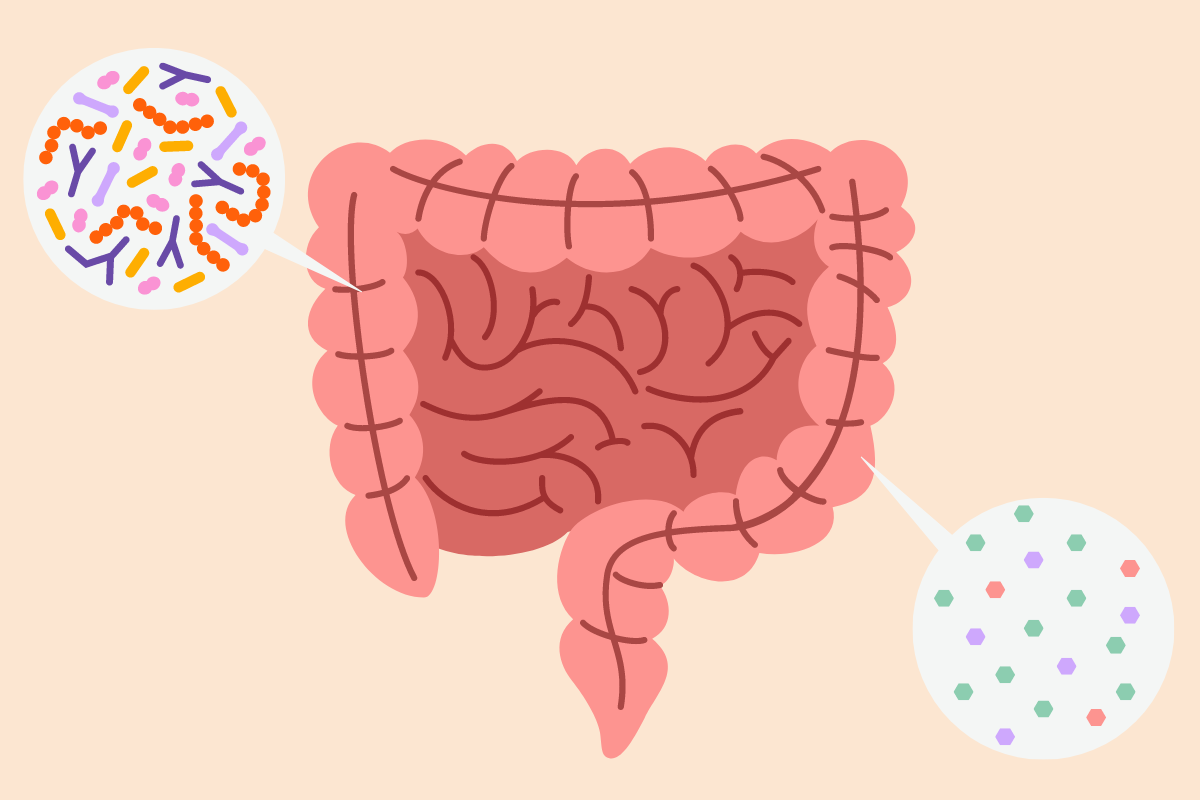gut skin
Probiotics vs. Prebiotics - Understanding the Key Differences
Both prebiotics and probiotics can benefit your digestive health but work in different ways. When combined together, they work synergistically to promote optimal health.

Both prebiotics and probiotics can benefit your digestive health but work in different ways. When combined together, they work synergistically to promote optimal health.
The importance of gut health has been a hot topic as of late, which means we’re seeing the terms “probiotics” and “prebiotics” thrown around a lot. Despite them being at the center of the conversation in the wellness world, many people don’t actually know the difference between the two.
Let’s do a deep dive into probiotics vs. prebiotics, as well as why (and how!) to include both in your wellness routine.
A Crash Course on the Gut Microbiome

Before we talk about the difference between probiotics and prebiotics, it’s important to have an understanding of the gut microbiome. The gut microbiome refers to the community of microorganisms (including good bacteria, AKA probiotics) that live in your gastrointestinal tract – primarily in the small and large intestines.
A healthy gut microbiome contains a wide variety of good bacteria and other helpful microorganisms. These microorganisms have many roles, including fighting pathogens which can cause illness and ensuring proper nutrient absorption.
Research shows that a healthy gut microbiome supports a strong immune system, healthy metabolism, and better digestion. A healthy gut microbiome also positively impacts our mood and mental health, and plays a vital role in keeping our skin clear and healthy. This is exactly why gut health has been in the spotlight lately!
When there is a lack of diversity or gut dysbiosis – when there are harmful levels of bad bacteria and too few good bacteria– this negatively impacts our overall health. At first, it may start with more subtle symptoms, such as fatigue, bloating, poor digestion, and skin breakouts, but overtime, gut dysbiosis can lead to a host of chronic conditions. It has been linked to inflammatory skin diseases, such as psoriasis, atopic dermatitis, acne, and rosacea, as well as metabolic diseases, including diabetes, and obesity.
A variety of factors can impact gut balance, harming this community of bacteria. This includes diet, stress, poor sleep, and certain medications.
What are Probiotics and Prebiotics?
Now that we understand the gut microbiome, let’s define probiotics and prebiotics, and talk about their connection to each other.
Probiotics: The “Good” Bacteria
Probiotics are good bacteria that make up various microbiomes throughout the body (including not just the gut microbiome, but also the vaginal microbiome, skin microbiome, and oral microbiome). They support digestion, immunity, mood health, skin health, reproductive health, and oral health.
You may have heard of a few common probiotic species, such as L. acidophilus (Lactobacillus acidophilus), but there are many! We’re talking hundreds!
Other examples include:
Lactobacillus
- Lactobacillus acidophilus
- Lactobacillus plantarum
Lacticaseibacillus
- Lacticaseibacillus rhamnosus
- Lacticaseibacillus paracasei
Bifidobacterium
- Bifidobacterium animalis ssp lactis
- Bifidobacterium breve
Each of these different bacteria offer their own benefits. When your gut microbiome is home to a diverse range of probiotic strains, it’s able to operate at its absolute best.
Prebiotics: Probiotic Fuel for Gut Health
In order for probiotics to multiply and function optimally, they need fuel. That’s where prebiotics come into play.
Prebiotics include several types of fiber (although it should be noted that not all fibers are prebiotic) known to resist digestion in the human small intestine and reach the colon where they are fermented by the gut microflora. This fermentation creates end products, such as lactic acid or short-chain-fatty acids (SCFAs), which provide a wide range of benefits, from strengthening the gut lining, absorbing nutrients better, and protecting against infection.
In other words, if you want to improve the efficacy of your probiotics, you also need prebiotics.
Just like probiotics, prebiotics can be found in foods, and are also added to supplements. Examples of food sources of prebiotics include artichokes, asparagus, berries, apples, oats, chicory, pistachios, legumes, cocoa, onions, garlic, and leeks.
When prebiotics are added to supplements, they often won’t name the food source on the label. Rather, you might see words like inulin, fructooligosaccharides, oligofructose, or galactooligosaccharides. They sound complicated, but rest assured – these are all just prebiotics!
Is it Better to Take Probiotics or Prebiotics?
If you’re looking for a winner in the probiotics vs. prebiotics challenge, the truth is, it’s a tie! You need them both, and they both work together synergistically to improve and maintain gut health for optimal wellness.
Is it Good to Take Prebiotics and Probiotics Together?
It’s a great idea to take probiotics and prebiotics together to maximize efficacy.
Food wise, add an ounce of sauerkraut to a meal that includes prebiotic veggies, such as asparagus or artichoke hearts.
If you’re not an avid cook, or know you won’t be able to always add fermented foods and prebiotic-rich foods to your plate daily, consider a prebiotic and probiotic supplement, such as Glow Biome, which combines the two. Just stay on top of taking the recommended dosage each day, and you’ll be giving your gut extra support to help it thrive!
Benefits of Taking Probiotics and Prebiotics
There’s no shortage of benefits that come with taking probiotics and prebiotics. Here’s a glimpse into a few ways they support the body:
- Supports Gut Health: Probiotics support healthy digestion, regularity, minimize bloating, and aid in nutrient absorption.
- Supports the Immune System: Probiotics may help regulate the immune system and fight harmful pathogens, preventing infections.
- Supports Skin Health: Research shows that oral probiotics can have a major impact on the skin. Certain strains support skin clarity, improve hydration and enhance skin barrier function. There is even evidence that an imbalance in the gut microbiome can be connected to conditions like psoriasis, atopic dermatitis, and acne, and that supplementation may help manage these conditions.
- Supports Mental Well-Being: If you’ve heard of the gut-brain axis, you already know that gut health and our mental wellbeing are closely related. Early research indicates probiotics and prebiotics may play a role in improving cognition and mood, as well as reducing levels of anxiety.
- Supports Vaginal Health: Several studies demonstrate the ability of Lactobacillus to adhere to vaginal and cervical epithelial cells, and many Lactobacillus strains have been shown to be helpful in preventing infections, like yeast infections or BV.
How To Choose a Probiotic and Prebiotic Supplement

Of course, choosing the right prebiotic and probiotic supplement is crucial – and unfortunately, not all formulas are created equally. Let’s talk about our top tips for choosing the best supplement.
1. Look for a Probiotic and Prebiotic Supplement
The first tip is obvious: make sure it has prebiotics! Not all probiotic supplements include prebiotics, so double check before you press the add to cart button. WIthout them, you may not get the optimal results from the formula, even if it has a great combination of probiotic strains.
2. Go for One with Multiple Probiotic Strains
Make sure the formula has at least five strains of probiotics. As mentioned, the gut microbiome loves diversity. A supplement with just one or two strains can be helpful, but it's not going to offer the same effects as a supplement with more. Don’t just take our word for it. Research shows that formulas with multiple strains offer better results compared to single strain supplements.
3. Check for Clinical Validation
There are thousands of supplements on the market, so how do you cut through the noise to ensure you’re getting a product that works? Look for companies that stand by their product and send them out for third-party human clinical testing.
For example, Glow Biome is a Probiotic + Prebiotic supplement that was clinically validated to support gut and skin health in a 12-week human clinical trial. Participants experienced better digestion and regularity, as well as clearer, healthier, more hydrated skin by the end of the study. See the results for yourself. For the sake of not wasting your time or money, pass on supplements that don’t invest in research!